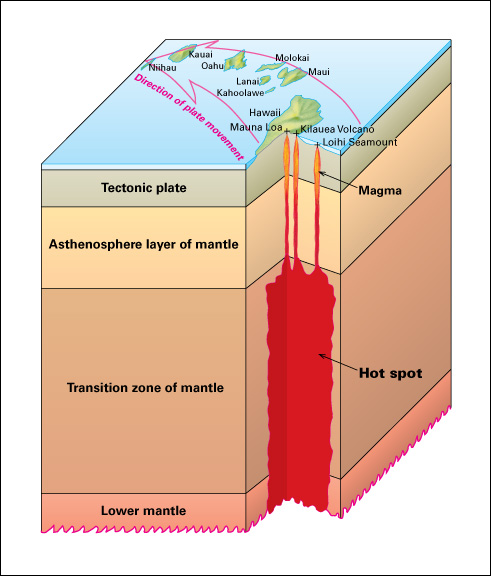Hot spot, also spelled hotspot, is an underground concentration of heat that creates volcanoes. The heat melts rock beneath Earth’s crust (rocky outer shell) in a layer called the mantle. The melted rock, called magma, rises to the surface, where it erupts as lava. Hot spot volcanoes occur on land and, more commonly, in the ocean. Oceanic volcanoes begin as submerged seamounts . Some oceanic volcanoes eventually rise above the water, becoming islands.

Hot spot volcanoes are relatively rare. In contrast, most volcanoes occur where magma wells up along the boundaries between tectonic plates. Tectonic plates are the rigid pieces of rock that make up Earth’s outer shell. They consist of the crust and the outer part of the mantle. The plates move constantly over the lower part of the mantle.
As a tectonic plate moves over a hot spot, successive volcanoes may form over the hot spot, creating a chain. For example, a single hot spot under the Pacific Ocean generated a line of volcanoes that became the Hawaiian Islands. The formation of the islands continues today with a seamount named Loihi << loh EE hee >> .

Some hot spots erupt over a broad area of the mantle. These hot spots can produce volcanoes over a wide region, rather than a distinct chain. Some scientists think a single hot spot can create seemingly unconnected volcanoes located hundreds of miles apart.
Many scientists think that at least some hot spots are fed by narrow, rising columns of hot mantle rock. These columns are called plumes. Above the plume, rising magma pushes its way through the crust to form volcanoes. When the head of a plume first rises to meet the crust, it can produce enormous outpourings of lava over a short time. Scientists do not fully understand the nature of the plumes, nor do they know where the plumes originate. Alternatively, some researchers are exploring other theories of hot spot formation.
Hot spots can persist for more than 100 million years. However, other hot spots appear to not have a long-lasting source. Geologists have traditionally thought hot spots remained fixed in place within the mantle. But many researchers now think that hot spots can change position and shape.
